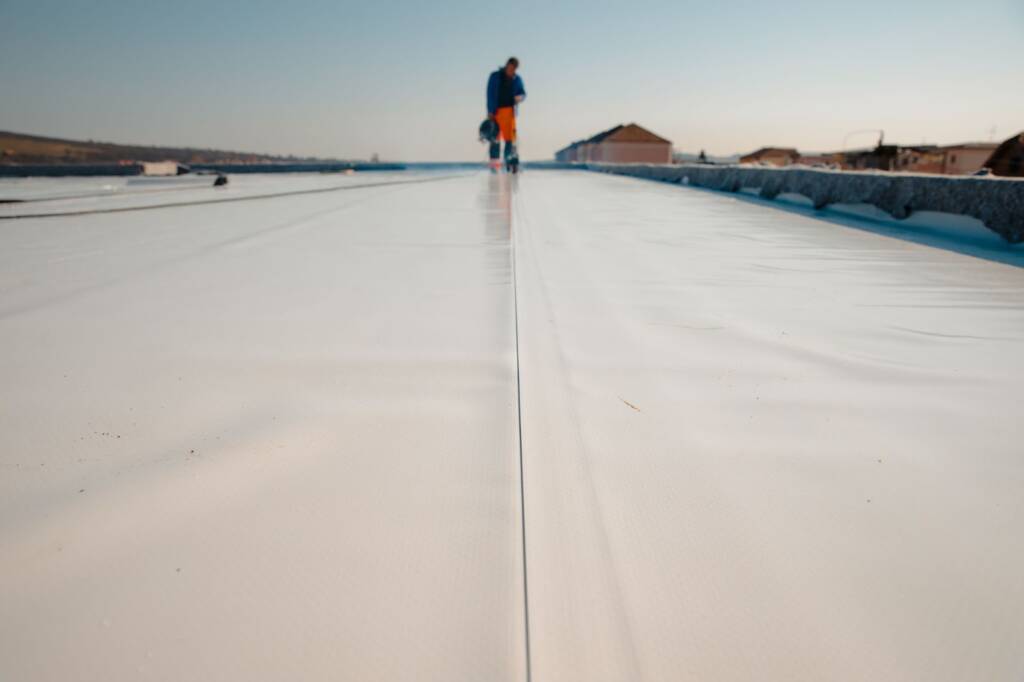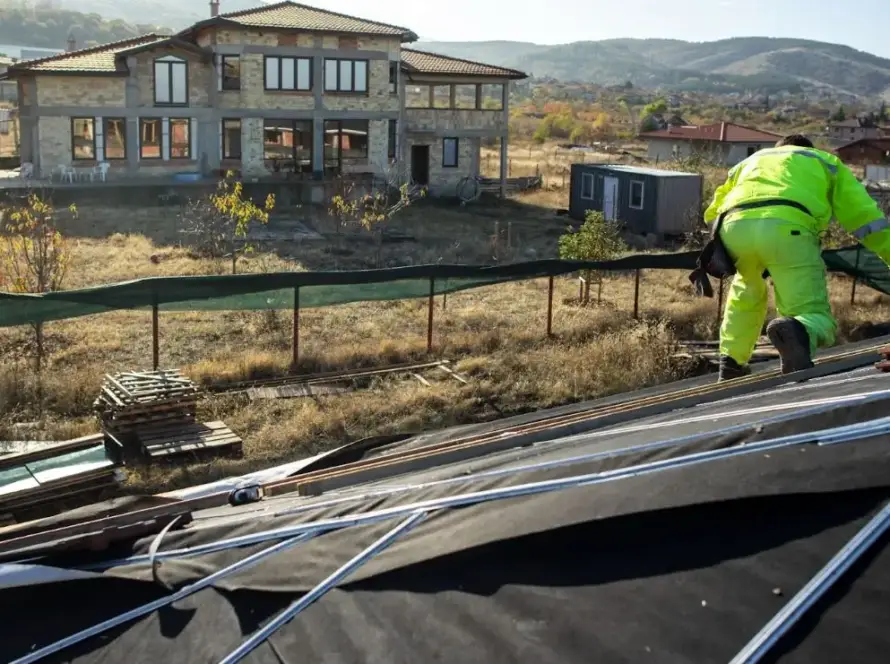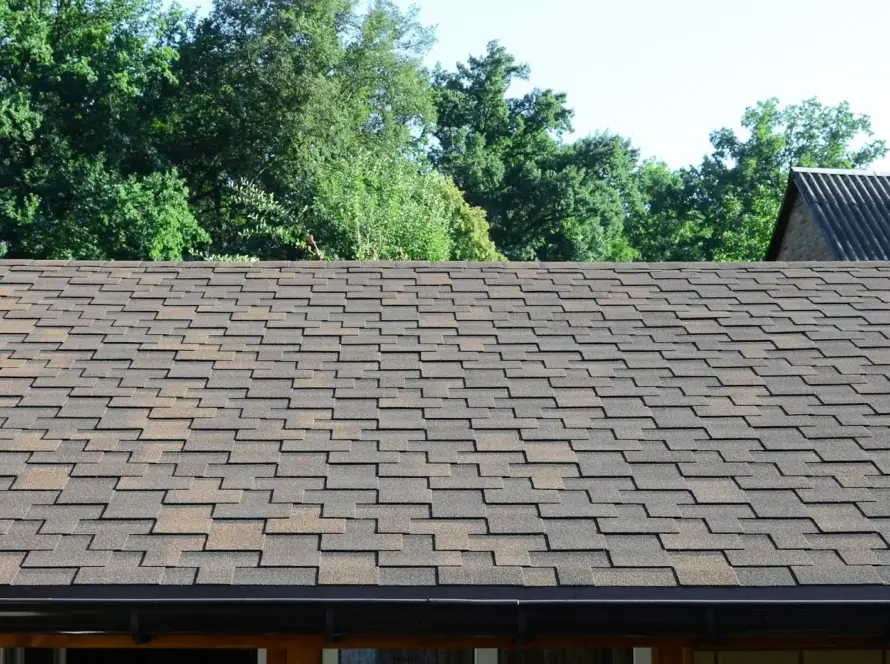Roofing decisions impact a building’s longevity and efficiency. Property owners seek materials that balance durability, cost, and performance. TPO roofing has gained popularity for its resilience and energy-saving benefits. Understanding its features and advantages helps you make the right investment.
What is TPO Roofing Exactly?
TPO stands for Thermoplastic Polyolefin, a single-ply roofing membrane. This material is designed for flat or low-slope roofs and offers durability and energy efficiency. It combines affordability with excellent weather resistance, making it a preferred choice. As more businesses and homeowners seek sustainable solutions, TPO continues to gain traction in the roofing industry.
Composition and Material Structure
TPO roofing consists of polypropylene and ethylene-propylene rubber. The blend enhances flexibility while ensuring long-term durability. UV stabilizers and antioxidants are incorporated to prevent damage from prolonged sun exposure. Reinforced layers strengthen the material against extreme weather conditions, reducing the risk of cracks or leaks. Its composition also contributes to resistance against mold, dirt accumulation, and chemical exposure.
How TPO Roofing Differs From Other Roofing Materials
Compared to PVC, TPO is more cost-effective and environmentally friendly. While EPDM requires adhesives for installation, TPO uses heat-welded seams for firmer bonding. Unlike darker roofing materials, TPO’s reflective surface reduces cooling costs. Additionally, TPO’s surface resists mold growth, dirt accumulation, and chemical damage, making maintenance easier. These qualities set it apart as a versatile and budget-friendly roofing option.
Benefits of TPO Roofing
Choosing TPO roofing provides multiple advantages, from cost savings to durability. The material can withstand various environmental conditions while promoting energy efficiency. Its adaptability to different roofing needs makes it a preferred option for commercial and residential properties. Property owners benefit from a roofing system that balances affordability with long-term performance.
Energy Efficiency and Cost Savings
TPO roofing features a reflective surface that minimizes heat absorption. Reducing indoor temperatures helps lower cooling expenses, particularly in warm climates. Many buildings equipped with TPO roofs meet modern energy standards. This advantage translates to long-term savings on utility costs. Choosing a roofing material that optimizes temperature control is a wise financial decision.
Longevity and Durability
TPO membranes resist cracks, punctures, and tears. Proper maintenance can last 20-30 years, making them a reliable choice. The heat-welded seams create a watertight barrier, preventing leaks and water damage. Mold and algae resistance contribute to the overall longevity of the roof. This durability ensures that property owners get the most out of their investment.
Weather and Chemical Resistance
TPO roofs perform well under various weather conditions, from extreme heat to heavy rainfall. Their UV resistance prevents premature aging and degradation. Industrial pollutants and chemical exposure do not easily damage the material. Strong winds and harsh weather elements are less likely to cause significant wear. These features make TPO a resilient choice for long-term roofing solutions.
TPO Roofing Installation Process
Proper installation is key to maximizing the benefits of TPO roofing. The process involves specific techniques that ensure a strong and durable roof. Installation methods vary based on roof design, climate, and budget considerations. Employing professional installation enhances performance and extends the roof’s lifespan.
Methods of Installation
Heat welding is the primary method used to seal TPO seams securely. Fully adhered systems provide added stability in regions with strong winds. Mechanically fastened systems rely on screws and plates for reinforcement. Ballasted installation involves using heavy stones or pavers to hold the membrane in place. Each method is chosen based on roof size, climate, and structural requirements.
Installation Timeline and Considerations
The duration of installation depends on the roof’s complexity and weather conditions. Most projects are completed within a few days to a week. Proper surface preparation is essential to ensure strong adhesion and prevent future issues. Hiring skilled roofing professionals ensures that the system is installed correctly. A well-installed TPO roof delivers long-term benefits with minimal maintenance.

TPO Roofing Maintenance and Repair
Maintaining a TPO roof is crucial for ensuring its longevity and performance. Regular inspections help identify and resolve potential issues before they escalate. Cleaning and minor repairs prevent costly damage, extending the roof’s lifespan. Proper care enhances the efficiency and reliability of TPO roofing.
Routine Inspections and Cleaning
Periodic inspections help detect minor damages that could lead to leaks. Accumulated dirt and debris should be cleared to prevent deterioration. Using appropriate cleaning methods preserves the integrity of the membrane. Checking for loose seams ensures that the roofing system remains secure. Regular upkeep reduces the risk of major repairs.
Common Repairs and Solutions
Minor punctures or tears can be sealed using heat-welded patches. Over time, seams may require resealing to maintain a watertight barrier. Promptly addressing damage prevents water infiltration and structural issues. Professional repair services ensure that fixes are durable and long-lasting. Preventative maintenance minimizes the likelihood of unexpected roofing failures.
Choosing the Right TPO Roofing System
Selecting the best TPO roofing system depends on multiple factors: thickness, color, and installation type influence overall performance. Climate conditions and budget considerations also play a role in decision-making. Consulting with experts helps you choose the most suitable option.
Thickness and Color Options
TPO membranes are available in various thicknesses, typically 45 to 80 mils. Thicker membranes offer increased durability and puncture resistance. White, gray, and tan colors provide different levels of solar reflectivity. Lighter colors enhance energy efficiency by reflecting more sunlight. Choosing the right thickness and color impacts long-term performance and cost savings.
Factors to Consider Before Installation
Climate and weather patterns affect the longevity and performance of TPO roofs. Budget constraints should be evaluated alongside long-term maintenance costs. Compliance with local building codes ensures a hassle-free installation process. Warranty options provide additional security for property owners. Making informed choices enhances the value of the investment.
Comparing TPO Roofing to Other Roofing Systems
TPO roofing is often compared to other single-ply roofing materials like EPDM and PVC. Each material has unique strengths and weaknesses, making it essential to evaluate them based on durability, cost, and performance. Understanding these differences helps property owners choose the most suitable option:
TPO vs. EPDM
EPDM (Ethylene Propylene Diene Monomer) is a synthetic rubber roofing material. While TPO and EPDM are widely used for commercial roofing, they differ significantly. TPO offers better heat reflection, reducing energy costs, while EPDM absorbs heat due to its dark color. EPDM also requires adhesives for installation, whereas TPO uses heat-welded seams, creating more potent and watertight bonds. TPO also provides superior resistance to punctures and tears compared to EPDM.
TPO vs. PVC
PVC (Polyvinyl Chloride) roofing is another thermoplastic membrane similar to TPO. However, PVC tends to be more expensive due to its chemical composition and enhanced flexibility. While both materials offer excellent UV resistance and durability, PVC has superior chemical resistance, making it ideal for industries dealing with grease, oil, or harsh chemicals. TPO, on the other hand, is considered more environmentally friendly and cost-effective. Many property owners opt for TPO because of its affordability and comparable performance.
Environmental Impact of TPO Roofing
TPO roofing is increasingly recognized for its eco-friendly benefits. As sustainability becomes a key focus in the construction industry, more property owners choose TPO for its minimal environmental footprint. This roofing system reduces energy consumption and supports recycling initiatives, making it a responsible choice for modern buildings.
Recyclability and Sustainability
TPO roofing is 100% recyclable at the end of its lifespan. Unlike traditional roofing materials that contribute to landfill waste, TPO membranes can be repurposed for new roofing systems or other construction materials. Many manufacturers incorporate sustainable practices in production, reducing environmental impact. Additionally, its long lifespan means fewer replacements, decreasing material waste over time.
Contribution to Energy Efficiency
TPO’s reflective surface reduces heat absorption, leading to lower cooling demands. Buildings with TPO roofs often qualify for energy efficiency certifications such as LEED and ENERGY STAR. By reducing energy consumption, TPO helps decrease greenhouse gas emissions. Property owners benefit from lower utility costs while making a positive environmental impact.
What is TPO Roofing’s Future in the Industry?
The roofing industry continues to evolve, with TPO becoming an increasingly popular choice. Demand for sustainable and energy-efficient solutions is driving innovation. Advances in manufacturing and installation improve the performance of TPO roofs, and more property owners recognize their cost-effectiveness and durability.
Advancements in TPO Roofing Technology
New material formulations enhance flexibility and weather resistance. Improved manufacturing techniques reduce environmental impact while increasing efficiency. Advanced seam-welding methods provide stronger, longer-lasting bonds. Innovations help TPO roofing adapt to different climates and conditions, making TPO an even more reliable choice.
Market Trends and Growing Demand
Many industries opt for TPO due to its affordability and energy efficiency. Stricter building codes encourage using reflective roofing materials, and green building certifications recognize TPO as a sustainable option. More contractors specialize in TPO installation, increasing accessibility. The market shows no signs of slowing down as interest in TPO grows.

Upgrade to TPO Roofing for Long-Term Benefits
Your roof is more than just a protective barrier—it’s an investment in comfort, efficiency, and peace of mind. TPO roofing offers a rare blend of affordability, resilience, and sustainability, making it an intelligent choice for forward-thinking property owners. By choosing TPO, you’re not just installing a roof but securing a solution that works with you, not against you.
Smart roofing starts here! Visit our Pinnacle Roofing LLC blog for expert advice and industry updates.


